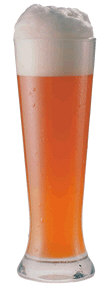Untitled Document

|
|
|
|
Hefeweizen
Also Known As: Weizenbier, Weissbier, Weizen
By law, a Hefeweizen (also known as Weizenbier) must be made from at least 50% malted wheat (Weizen). The remaining grain is usually malted barley. Most Weizenbier from Bavaria is made from 60-70% malted wheat.
Hefeweizen is also known as Weissbier, (meaning "white beer") due to its yellow-white color. In America, this beer is most often sold as Hefeweizen, (meaning "yeast wheat") because it is unfiltered, keeping yeast in the beer and making it unclear.
| |

Photo: © Deutsche Brauer-Bund |
| |
|
Classification: Vollbier
Type of Beer: Ale
Alcohol Content: 5.4%
Extract Value: 11-14%
IBU: 8-15
Region: Mainly in Bavaria (Bayern) but growing in popularity throughout Germany
Well Known Brands
Paulaner, Erdinger
Beer Characteristics
Slightly unclear; light in color. The taste is often described as fruity (similar to a banana) or as sour and spicy. Very mild hops taste. A glass Weizenbier always has a tall, white, creamy foam (head) on top.
Serving Suggestions
For optimal taste, serve chilled (46-50° F / 8-10° C) and in a traditional tall, slender glass. The tallness of the glass gives the carbonation in the beer a long way to travel to the top, keeping the beer fresh and spritzy.
Often a Weizenbier is served with a slice of lemon. However, this is not a Bavarian tradition. It is believed that the juice from the lemon slice destroys the creamy foam - a very important part of the Weizenbier!
Store Weizenbier in a cool, dark place - where no sunlight can reach it (sunlight harms the flavor of the beer). Also, store upright, so that the yeast falls to the bottom of the glass.
Food Pairings
Weizenbier pairs well with seafood and poultry dishes, salads, mild cheese, and sweet desserts.
Weizenbier is also often mixed with other drinks:
Weizenradler: Weizenbier mixed with sparkling lemonade.
Bananenweizen: Weizenbier mixed with banana juice.
Kirschweizen: Weizenbier mixed with cherry juice.
Schwarze: Weizenbier mixed with cola and Kirsch liquor.
Colaweizen: Weizenbier mixed with cola.
History
The technology to create beer from wheat reached Germany (from Bohemia) in the 16th century. It was a Bavarian brewer who invented Weizenbier in 1520.
Additional Information
Most Weizenbiers are tank- or bottle-conditioned. This means that fresh, unfermented beer is added to the ripe, fully fermented beer just before bottling or adding to a keg. The yeast in the fully fermented beer is basically given "fresh food" from the unfermented beer. This causes fermentation to continue in the bottle or keg - the yeast converts the new sugar into alcohol and carbon dioxide. The carbon dioxide becomes trapped in the bottle or keg, creating Weizenbier's great effervescence.
|
| |
|
|
|

